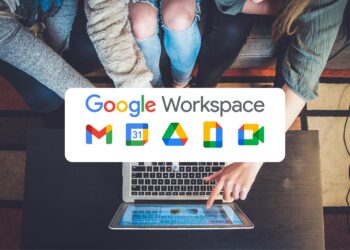This quick-start how-to post companion guide gives you step-by-step instructions to set up Google Workspace for your household. From managing calendars to tracking chores and budgets, it’s everything you need to bring order to the chaos — fast.
Companion Post: How Every Household Can Use Google Workspace for Household Management
Download: How-To Guide: Setting Up Google Workspace for Household Management (Step-by-Step)
Step 1: Create a Shared Family Google Account (Optional but Recommended)
Why: Keeps household documents, calendars, and apps centralized.
Instructions:
Go to accounts.google.com.
Click “Create account” → Choose “For my personal use”.
Use a handle like: smith.familyhouse@gmail.com.
Share the login and password with your spouse/partner (store securely).
Turn on 2-Step Verification under Security Settings for added safety.
Step 2: Set Up Google Drive for Household Files
Why: Central storage hub for documents, records, and plans.
Instructions:
Visit drive.google.com.
Click “New” → “Folder” → Name it Family HQ.
Inside, create subfolders:
Finances
School
House Projects
Medical & Insurance
Pets
Upload relevant documents or scan paperwork using the Google Drive mobile app.
Pro Tip: Right-click any folder → “Share” → Add emails of family members and assign permissions (view, comment, edit).
Step 3: Create and Share Google Calendars
Why: Keeps everyone on the same page — from soccer practice to trash day.
Instructions:
Go to calendar.google.com.
On the left sidebar, click the “+” next to ‘Other calendars’ → “Create new calendar.”
Make calendars like:
Family Events
Kids Schedule
Bills & Reminders
Meal Planning
After creating each one, go to “Settings and Sharing” → Add family members via email.
Add recurring events like:
Weekly meal planning: Every Sunday at 5 pm
Garbage day: Every Thursday
Medication reminders
Step 4: Set Up a Household Budget in Google Sheets
Why: Helps track spending, savings, and prevent financial leaks.
Instructions:
Go to sheets.google.com.
Click “Blank” or use a budget template (Search “Monthly Budget” under Template Gallery).
Customize categories:
Income
Rent/Mortgage
Utilities
Groceries
Subscriptions
Share with partner via the Share button.
Use functions like =SUM(), =IF(), and conditional formatting to automate.
Step 5: Create Shared Docs for Planning and To-Do Lists
Why: Central hub for collaborative notes and plans.
Instructions:
Open docs.google.com
.
Create a new document: Weekly Groceries List or Home Renovation Plan.
Use bullet points, tables, or headers for structure.
Click Share → Add collaborators → Assign edit or comment rights.
Use Comments to tag others with @Name for tasks or suggestions.
Bonus: Use version history (File → Version History) to track changes.
Step 6: Build Interactive Checklists in Google Keep or Google Tasks
Why: Break down tasks with reminders, and accessible on mobile.
For Google Keep:
Go to keep.google.com.
Click “Take a note…” → Use the checkbox icon for lists.
Title ideas:
Grocery List
Vacation Packing
Emergency Kit
Share with family by clicking the Collaborator Icon.
For Google Tasks:
Open Gmail or Calendar → Right-hand side panel → Click Tasks.
Create task lists like:
“Household To-Dos”
“Kids Chores”
Add due dates → They auto-sync with Google Calendar.
Step 7: Use Google Forms for Family Feedback or RSVP
Why: Collect inputs quickly from the whole crew.
Instructions:
Go to forms.google.com.
Click Blank Form.
Example Form Titles:
“What Should We Eat This Week?”
“Birthday Party RSVP”
“Chore Completion Tracker”
Add multiple-choice, short answers, or checkboxes.
Click “Send” → Share via email or link.
Step 8: Use Gmail and Google Chat for Communication
Why: Reduce scattered messages across apps.
Gmail: Go to gmail.com.
Create filters for:
Bills (has the word “invoice”)
School (from:@school.edu)
Label emails (e.g., “Important,” “Action Needed,” “Receipts”).
Google Chat:
Go to chat.google.com
or open from Gmail.
Start a group named “Family HQ” or “House Stuff.”
Use threads for topics: groceries, schedules, to-dos.
Step 9: Organize Schoolwork and Projects
Why: Helps kids stay focused and parents stay informed.
Instructions:
Create folders for each child in Google Drive: e.g., Emma – Grade 8.
Inside: Homework, Projects, Teacher Notes.
Teach kids to use Docs for assignments, Sheets for tracking grades.
Use Google Calendar for school events and assignment due dates.
Step 10: Build Emergency Kits and Protocols
Why: Keeps your family prepared.
Instructions:
In Docs, create:
Emergency Contact List
First Aid Instructions
Evacuation Plan
In Sheets, inventory supplies:
Food
Flashlights
Water bottles
Set recurring reminders in Calendar to check or replace items yearly.
Step 11: Create Vision Boards with Google Slides
Why: Set long-term family goals and dreams together.
Instructions:
Go to slides.google.com.
Title your deck: Family Dream Board 2026.
Use each slide for a goal:
Vacation in Italy
Home Garden Project
Debt-Free Plan
Insert images, links, quotes, and even videos.
Present together and assign tasks to make dreams real.
Step 12: Maintain the System Monthly
Why: Keeps everything clean, relevant, and efficient.
Tips:
End of each month: Review budget, calendar, and Drive folders.
Archive outdated files.
Reassess family goals every 6 months.
Encourage kids to take ownership of their own folders and tasks.




